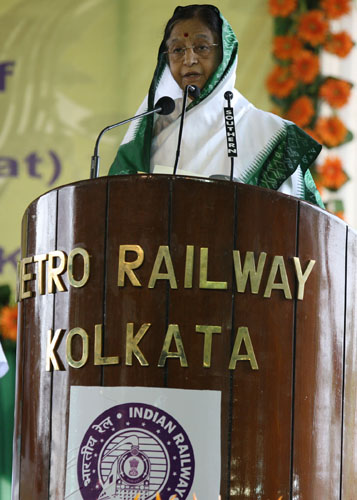Speech by Her Excellency the President of India, Shrimati Pratibha Devisingh Patil at the Foundation Stone Laying Ceremony of the Joka to Binoy Badal Dinesh (Bbd) Bagh Section
Kolkata, West Bengal : 22.09.2010

It gives me great pleasure to participate on the occasion of the Extension of the Metro Railway services in Kolkata - the City of Joy. I would like to compliment the Indian Railways who under the dynamic leadership of Mamataji, Minister of Railways, have today undertaken this significant initiative. The contribution of the Railways to the development of the country has been immense. They have linked the various parts of the country, moving goods and people since their establishment.
The rail age dawned in India on 16th April, 1853, when a train with 14 railway carriages and 400 passengers left Bori Bunder for Thane. The journey took an hour and 15 minutes, and it was the first commercial passenger service in India. From a traditional carrier of men and materials, today the Indian Railways has emerged as one of the largest railway networks under a single management in the world. Not only does it move over 900 million tonnes of freight, its stupendous size and reach is reflected in the fact that the twenty two million passengers it carries daily equals the population of Australia.
If one looks at trends, it is evident that the urban population across the world has been increasing. Today, half of humanity lives in cities and according to assessments, the 21st Century is likely to be the Century when cities will be the dominant human habitats. India too has a growing urban population. Between 1991 and 2001 there was an addition of 68 million to our urban population, marking a decadal growth rate of about 31 percent and taking the number of city dwellers to 286 million. Growing urbanization calls for planning ahead for the future, by focusing on issues of urban management and urban governance. Moreover, as the population of cities grow, it is essential to have mass transport and transit systems that facilitate movement within the city. In their absence, city dwellers would depend on private transportation, leading to congestion, pollution and more fuel consumption. In a city, a metro system is an effective system of travel, giving the people a convenient, comfortable and an affordable mode of travel.
The historical city of Kolkata has occupied a predominant position in the thought and culture of modern India. The city has also grown as an industrial and trading hub. Such growth has not been without its con-commitant increase in population and the need to address issues of intra city traffic. This need, first felt in the early 1960s found fruition 25 years ago when the Kolkata Metro started its maiden run from Esplanade to Bhawanipur in 1984. The Kolkata Metro Rail is the only network being operated by the Indian Railways in this country. Extended in 1995 and then again in August 2009, it brought the South 24 Parganas District closer to Kolkata's Central Business District, and reduced substantially the enormous pressure on other modes of transport.
I am happy to learn that further extensions of over 85 kms. of the Kolkata Metro have been sanctioned in 2010. The Joka to Binoy Badal Dinesh Bagh stretch of the Metro railway expansion, for which we have gathered here today, would be linking hitherto inadequately connected areas of Joka to the heart of Kolkata. This will no doubt boost the existing network and add to it substantially. I am glad to learn that the alignment for the Joka - BBD Bagh section has been planned with due consideration for existing business activities and traffic, by choosing a mix of underground and elevated tracks.
Metro construction is of a very complex nature, requiring application of several new technologies in the fields of civil, electrical, signaling and telecommunication engineering. It is also heartening to note that the system has been conceived, planned, designed and executed by the Indian Railways in-house technical capabilities. It is important to take proper care at every stage from planning to execution and maintenance. Planning requires preparing work schedules and executing them in a matter that it does not disrupt normal life. I am also optimistic that a project such as this which is sensitive to the concerns of the local people will be completed in time and be a source of pride for all.
A principal reason for the success of Kolkata Metro is the people of Kolkata, who have loved and cared for it and made it a system to be proud of. I would like to congratulate the Railways Minister, Mamataji and her team of Officers, for embarking on yet another people friendly initiative which would benefit many.
The reputation of an organization depends upon the strengths and values of its personnel. The Indian Railways has made continuous efforts to upgrade itself technically, as well as through attitudinal change and team building. I hope that the role of the Railways in inclusive development and integration will be visible in the edifice of Kolkata Metro.
I wish to once again express my happiness to be here with all of you at the Foundation Stone Laying Function of the new Metro line between Joka and BBD Bagh. I wish the project and all connected with it progress and success.
Thank you,
Jai Hind.
